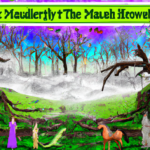
Introduction: Brief overview of The Wheel of Time series
The Wheel of Time is a series of epic fantasy novels written by the acclaimed author James Oliver Rigney Jr. under the pen name Robert Jordan. The series comprises 14 books, with the first book’s publication dating back to 1990. The Wheel of Time series follows the journey of a group of young people as they attempt to save the world from the encroaching darkness of the Dark One, an evil entity that seeks to remake the world in its own image.
The series is set in a world that Jordan has created, with its own history, mythology, religions, and geography. The books’ narrative has a wide array of characters, from Kings and Queens to soldiers and peasants, and explores their interwoven lives and relationships as they are drawn into the on-going conflict against the Dark One. The books contain a great deal of detail, rich character development, and a plot that is intricately woven together that will enthral any reader.
The Wheel of Time has become one of the most recognizable and beloved series in the fantasy genre. The books have sold in the millions globally and have been translated into over 25 languages. The series also has a significant following, with fans eagerly waiting for each new book to be published and actively discussing theories and speculating on what the next installment will bring. The Wheel of Time series is more than just a classic tale of good vs. evil, and this article will explore why it has captivated readers worldwide.
Background on Robert Jordan: His life and works
Robert Jordan, whose real name was James Oliver Rigney Jr., was an American author best known for his epic fantasy series, The Wheel of Time. Jordan was born in Charleston, South Carolina, in 1948 and served in the United States Army as a helicopter gunner during the Vietnam War. After his military service, he attended the Citadel, The Military College of South Carolina, where he earned a degree in physics. Jordan later worked as a nuclear engineer, and it wasn’t until he was in his thirties that he decided to pursue writing full time.
Jordan’s debut novel, “The Fallon Blood,” was released in 1980, followed by several other works in different genres. However, it wasn’t until the publication of “The Eye of the World,” the first book in The Wheel of Time series, that he gained widespread notoriety and acclaim. He continued to write and publish additional books in the series until his death in 2007.
Aside from his contributions to the fantasy genre, Jordan was also recognized for his extensive efforts in helping aspiring writers. He was an active member of the Science Fiction and Fantasy Writers of America, where he served as a regional director, and was committed to mentoring upcoming writers. His life and his contributions have inspired not only the fantasy genre but have also had a significant impact on the writing community.
Book review of The Wheel of Time series: Plot summary and characters
The Wheel of Time series is a story that takes place in a world that is both ancient and yet still filled with wonder and magic. The series features a vast and diverse cast of characters who are well-developed and multi-dimensional. Jordan’s characters come from various backgrounds, and their individual stories are interwoven with the larger narrative of the series.
The books follow Rand al’Thor, a young man from a small village who is thrust into a world of conflict and magic when he discovers that he is the prophesied savior, the Dragon Reborn. Rand’s journey is central to the series, and he undergoes significant character development throughout the books. Alongside Rand are other key characters, such as Egwene, Nynaeve, Mat, and Perrin, as well as several other supporting characters that add depth to the story.
The Wheel of Time series is known for its detailed plot, rich world-building, and intricate storytelling. Each book in the series is a sprawling epic that pulls the reader further into the world of the series, slowly uncovering its mysteries and revealing the true nature of the overarching conflict. The series is an impressive and ambitious piece of work, and the exceptional plot and characters make it a must-read for any fantasy or science fiction fan.
Writing style: Jordan’s prose and use of language
Robert Jordan’s writing style is highly regarded in the literary world, and his prose is often praised for its beauty, elegance, and complexity. Jordan is known for his ability to weave together intricate storylines, create compelling characters, and craft vivid descriptions that bring his world to life.
In The Wheel of Time series, Jordan employs a rich and extensive use of language that immerses the reader in the world he has created. His writing style is characterized by a vast vocabulary of descriptive words that convey the mood and atmosphere of the world he has created, as well as the feelings and motivations of his characters.
Jordan’s use of language is also notable for his creativity in naming and describing elements of the world he created. His character’s names and their backstories all have significant meaning, and Jordan masterfully weaves them into the plotline, often adding a layer of depth that elevates the story. His world’s diverse cultures and religions are all unique and integral to the narrative, with their own language and nuanced descriptions.
Jordan’s writing style is an essential ingredient that makes The Wheel of Time series exceptional. His ability to create a rich and detailed world alongside an intricate plotline and complex characters is a testament to his immense talent as a writer.
Critical reception: Response of readers and critics
The Wheel of Time series has garnered critical acclaim and has amassed a loyal fan base. It has been recognized on different occasions as one of the best fantasy series ever written. Many critics have praised Jordan’s world-building skills, character development, and his way of subverting fantasy tropes. Fantasy fans praise the series for its exceptional storytelling, richly detailed world, and the relatable and well-developed characters.
However, the series has not been without its share of criticism. One common criticism is that it became slow-paced as the series progressed, and at times, the plot felt repetitive. Additionally, some critics argue that the series’ great length and scale may have deterred some readers from completing it.
Despite these critical voices, the Wheel of Time series remains widely loved, and its influence can be seen throughout the fantasy genre. It has inspired countless fantasy works and remains an essential piece of the genre’s history. The Wheel of Time series has earned a place of distinction in the fantasy canon, and its critical and popular success continues to ensure its place in literary history.
Themes and motifs: Analysis of recurring themes and symbols
The Wheel of Time series is a story that explores various themes and motifs. One prominent theme is the struggle between good and evil, embodied in the conflict between the forces of the Dark One and the Light. Jordan’s approach to this classic trope subverts some of the typical fantasy genre’s conventions, as characters that are painted in shades of grey rather than black and white.
Another recurring theme is the importance of destiny and free will. This conflict is embodied in the central character, Rand al’Thor, who, despite being the prophesied saviour of the world, struggles with the weight of his destiny and the decisions he makes that shape his life. The series explores the idea that even those with a predetermined destiny are still in control of how they live and the choices they make.
Symbolism is pervasive throughout the series, with many important items or events recurring throughout the books. For example, the snake and eagle are recurring motifs in the book covers and chapter headers. The Aes Sedai flame and arch, along with the Dragon’s fang are all symbols that encapsulate the themes of the story.
The themes and motifs in the Wheel of Time series are complex and intricate, enriching the story’s narrative and offering a deeper layer of meaning. The symbolism, in particular, adds to the immersive experience of reading the books, leading readers to ponder the broader concepts they invoke. The series is a masterpiece of modern fantasy, and the themes and motifs present contribute to making it a must-read in the genre.
Conclusion: Final thoughts on The Wheel of Time series and its significance in fantasy literature
The Wheel of Time series is a remarkable achievement in fantasy literature, with a vivid world, a sprawling narrative, and intricate characters that have captured the hearts of millions of readers worldwide. The series has become a classic of the genre and has influenced many of the great works of modern fantasy.
Jordan’s legacy as a writer has been firmly cemented by the Wheel of Time series as he immortalized himself through his creation of an entirely original world. His commitment to detail, rich character development, and masterful storytelling all come together to create a story that has stood the test of time. This series’ significant cultural impact is clearly visible, with legions of fans who eagerly anticipate new releases and a TV adaptation currently in development.
The Wheel of Time is much more than just a classic tale of good versus evil. It is a sweeping epic that explores key themes of destiny, free will, and questions the very nature of what it means to be a hero. The series’ significance in the fantasy literary canon cannot be overstated, as it continues to inspire new generations of readers and writers alike. The Wheel of Time will always hold a special place in the hearts of those who’ve read it, and its influence will be felt in the genre for years to come.







